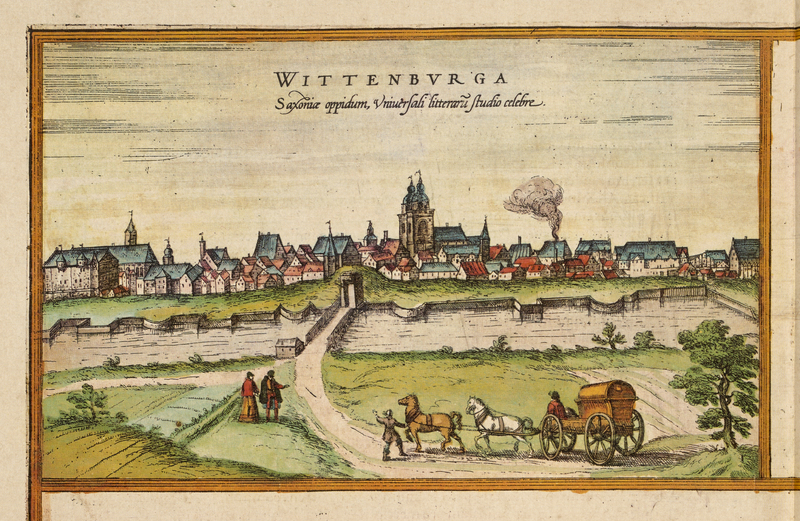Glossary
Carthusians – The Carthusians are a Catholic religious order, whose monks and nuns live as hermits in small communities. Since 1084 their main purpose has been contemplation in isolation. They do not use the Rule of St. Benedict but have their own. The order takes its name from the motherhouse in a part of the Alps near Grenoble, France.
Confession – The breakup of Latin Christianity resulted in the formation of distinct Christian communities called confessions; denominations in modern parlance (Lutherans, Zwinglians, Calvinists, Catholics, etc.). Such confessions were a new phenomenon in the sixteenth century since the medieval Church had encompassed the whole spectrum of Western European Christianity. These new religious groups defined their identity in part through legally binding documents called confessions of faith—a digest of a group’s main tenets, beliefs, and practices that supposedly united all adherents. Some Protestant dissenters refused to consolidate themselves in this fashion (e.g., the Anabaptists), and they were persecuted by practically all confessions.
Diet – The “Holy Roman Empire of the German Nation” was an elective kingdom. An assembly of the seven highest dignitaries of the empire consisting of both ecclesiastics and secular princes served as the electors. As a political body, the empire constituted itself when the empire’s estates gathered for diets, usually at one of the free imperial cities, to discuss wars, taxes, reforms, and other matters. Traditions rather than laws or a constitution steered their deliberations. Such gatherings were called by the king or emperor and held irregularly, though the fifteenth century witnessed a development toward institutionalization.
Humanism – Humanism is an intellectual movement that gained momentum in the fifteenth and sixteenth centuries. While there existed many strands of humanist thought, all humanists were unanimous in re-centering intellectual activity on language, especially the acquisition of ancient languages, rhetoric, and ethics—skills and disciplines they understood to have great practical value. As a result, humanists engaged ancient authors with a new spirit. This changing interest had vast implications for education, pedagogy, academic curricula, court life, and the arts.
Incunables – Publications printed in the fifteenth century are conventionally called incunables (incunabulum/incunabula), meaning that they were printed ‘in the cradle’ (in cuna) of printing history.
Indulgences – According to Catholic theology, indulgences entailed a reduction of the punishment one had to undergo for one’s temporal sins in Purgatory, the state in which the dead who will ultimately go to heaven purify themselves. In the late medieval church, one could buy such remittances or penance for oneself or for others, according to one’s means. Because the practice monetarized religious services, it was contentious. Martin Luther came to consider the sale of indulgences an abuse; and in 1517, he issued 95 Theses arguing that it had no theological basis. The resulting debate led to the breakup of Latin Christianity, an outcome that was not Luther’s original intent.
Instrumentum – Being a clever philologist, Erasmus strongly argued that the term “Instrumentum” was more exact that the widely accepted “Testamentum” for the New Testament. He explained that testament strictly means an oral statement of intent, whereas the written document reflecting that statement is called instrument. In other words, Erasmus argued, Christ left a testament to his disciples that, after being written down, became an instrument.
Initial – In order to orient readers in a text, layout is exceedingly important. Highlighting the beginning of units within a text such as chapters through colored, large, and occasionally ornamented letters was a standard in manuscript culture. In many incunables, printers left spaces to have these single letters painted by an illuminator after the print had been sold. In such cases, the print’s owner paid for the ornamentation.
Medium, media – This is a Latin term that denotes an in-between mediating between other elements. This concept has proven useful to direct attention from what is said in a given utterance (content) to the forms, formats, and modes of dissemination of a message. After all, these parameters have a profound impact on the message itself: “The medium is the message,” to quote Marshall McLuhan, one of the founders of media theory. In this sense, manuscripts are also a medium, and mass media are media defined by their vast distribution as well as particular technologies or modes of access. Arguably, printing commands our attention, among other things, as the first mass medium.
Philology – Philology refers to the systematic study of languages and literary texts. Philologists pay attention to the details of the linguistic record in order to gain better insight into canonical and other texts—word usage, the denotations and connotations of words, word histories, grammar, syntax, etc.
Vulgate – This is the name for St. Jerome’s fourth-century translation of the Bible from Hebrew and Greek into Latin. The word derives from the Latin versio vulgata—“the version commonly used.” Indeed, the Vulgate was the most widely used in medieval times. The sixteenth-century Council of Trent confirmed the Vulgate as binding for the Catholic Church.

War of Words. War of Images.

About the Exhibit
